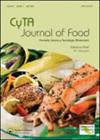响应面法(RSM)确定了鱼糜制品中鸡血浆蛋白(CPP)的最低含量,蛋白质溶解度、黏结性和白度最佳
IF 1.7
4区 农林科学
引用次数: 0
摘要
本试验旨在确定鸡血浆(X1)和山梨醇(X2)对鱼糜蛋白溶解度(Y1)、黏结性(Y2)和白度(Y3)的影响。响应面法(RSM)产生13个试验设计,鸡血浆蛋白(CPP)含量为0.5% ~ 2.5%,山梨醇含量为2% ~ 6%。结果表明,CPP浓度为0.79%,山梨糖醇浓度为4.68%时,鱼糜的蛋白溶解度、黏结性和白度最佳。结果表明,蛋白质溶解度约为49.09 mg/ml,黏结性为0.654,白度值为75.55。同时,蛋白质溶解度、黏结度和白度的最佳实验值分别为46.56 mg/ml、0.65 mg/ml和75.55 mg/ml。实测值与预测值差异无统计学意义(p > 0.05),说明RSM模型的有效性。这些发现对提高鱼糜产量具有重要意义。本文章由计算机程序翻译,如有差异,请以英文原文为准。
Response surface methodology (RSM) identifies the lowest amount of chicken plasma protein (CPP) in surimi-based products with optimum protein solubility, cohesiveness, and whiteness
This research aimed to determine the minimum amounts of chicken blood plasma (X1) and sorbitol (X2) that affect the protein solubility (Y1), cohesiveness (Y2), and whiteness (Y3) of surimi. Response surface methodology (RSM) generated 13 experimental designs ranging from 0.5% to 2.5% for chicken plasma protein (CPP) and 2% to 6% for sorbitol. The results show that optimal conditions for protein solubility, cohesiveness, and a whiteness of surimi were achieved with a CPP concentration of 0.79% and a sorbitol concentration of 4.68%. This resulted in a predicted protein solubility of approximately 49.09 mg/ml, cohesiveness of 0.654 and whiteness value of 75.55. Meanwhile, the optimal experimental values for protein solubility, cohesiveness, and whiteness were found to be 46.56 mg/ml, 0.65, and 75.55, respectively. The measured values and predicted values have no statistically significant difference (p > .05), indicating the validity of the RSM model. These findings are valuable for improving surimi production.
求助全文
通过发布文献求助,成功后即可免费获取论文全文。
去求助
来源期刊

Cyta-Journal of Food
FOOD SCIENCE & TECHNOLOGY-
CiteScore
4.40
自引率
0.00%
发文量
37
期刊介绍:
CyTA – Journal of Food is an Open Access journal that publishes original peer-reviewed research papers dealing with a wide range of subjects which are essential to the food scientist and technologist. Topics include: chemical analysis of food; additives and toxins in food; sensory, nutritional and physiological aspects of food; food microbiology and biotechnology; changes during the processing and storage of foods; effect of the use of agrochemicals in foods; quality control in food; and food engineering and technology.
 求助内容:
求助内容: 应助结果提醒方式:
应助结果提醒方式:


